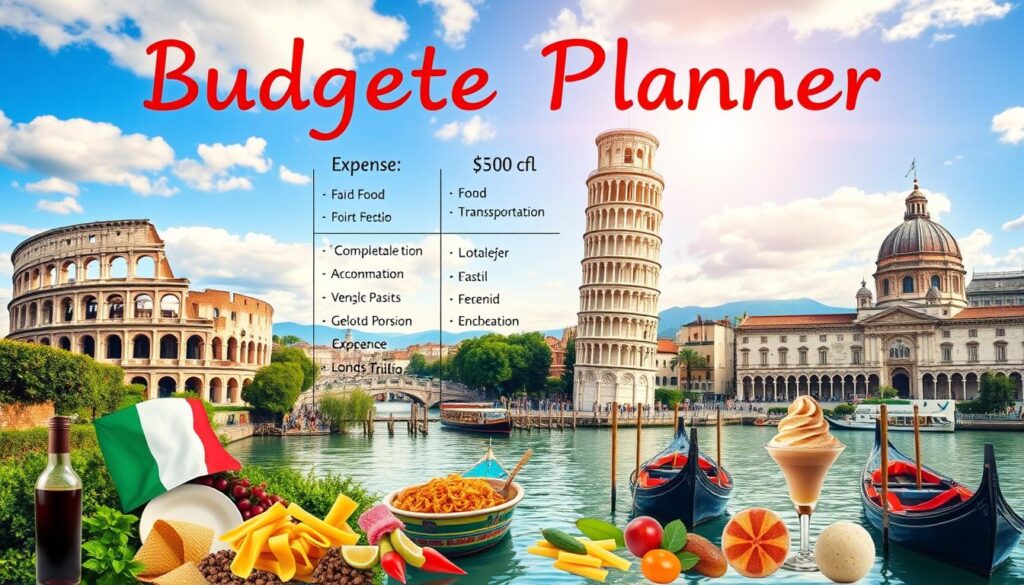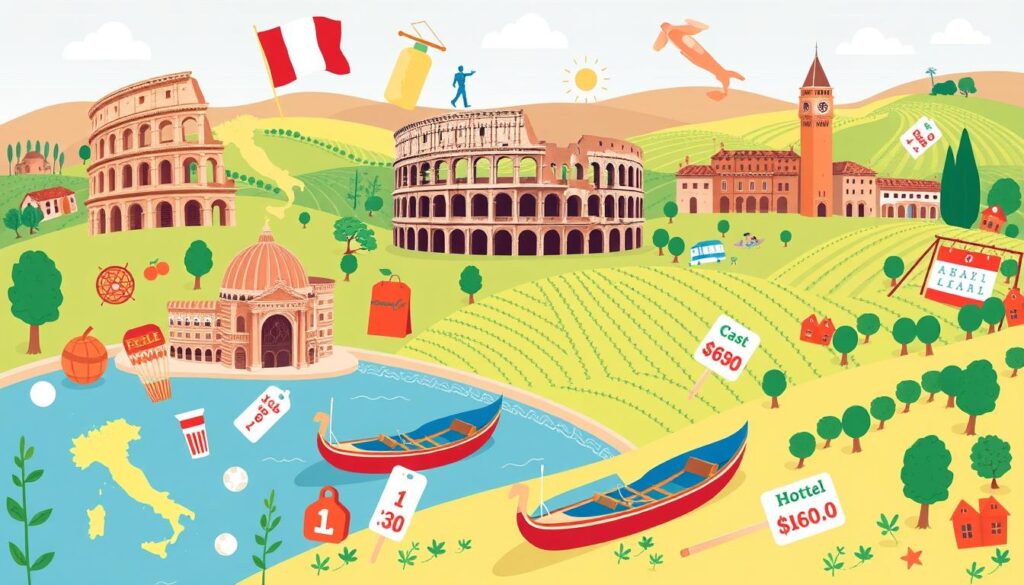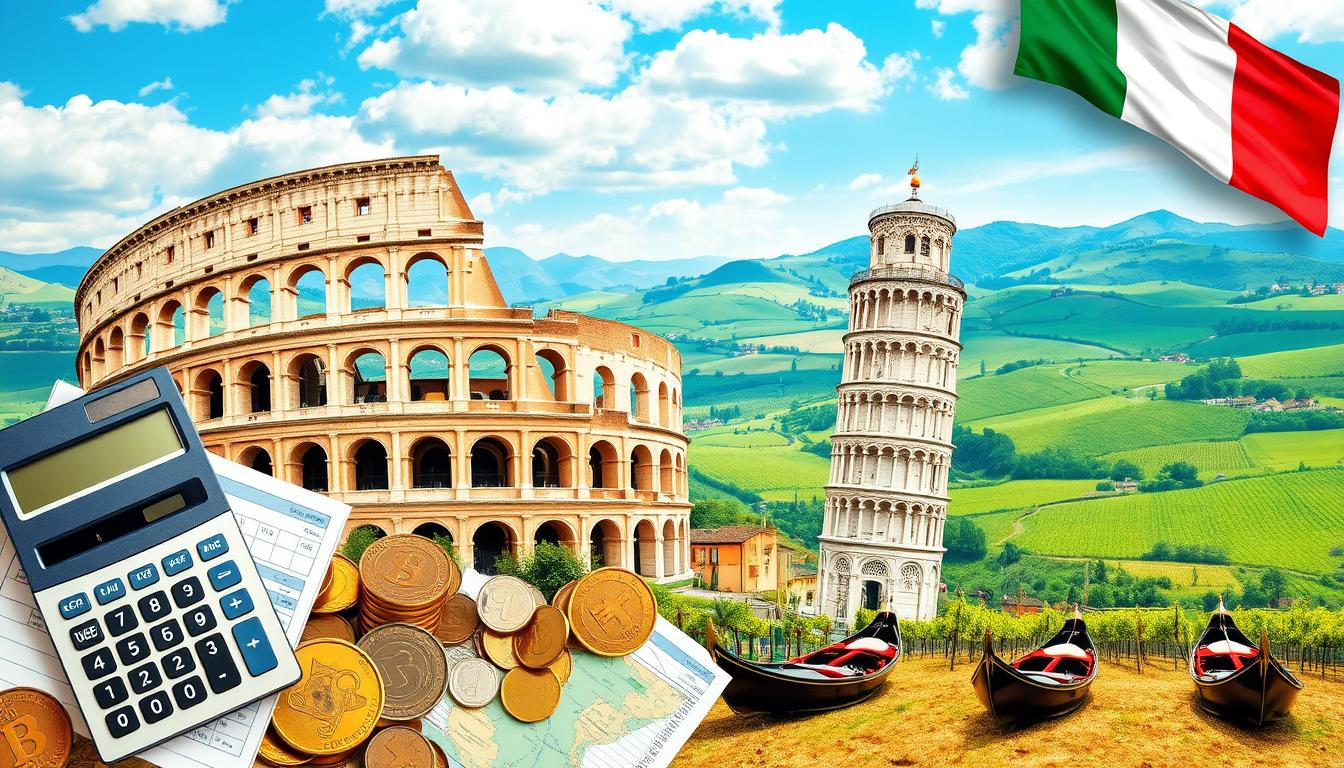Average Cost of Italy Trip: What You Need to Budget
Planning a trip to Italy is exciting. You’ll imagine walking through ancient ruins and trying delicious Italian food. But, you need to know how much it will cost to make sure it fits your budget.
A 10-day trip to Italy can cost between $2,500 and $4,000 per person. This includes flights, where you’ll stay, food, sights to see, and souvenirs. This range covers different travel styles, from cheap to luxury. Knowing this helps you plan a trip that’s both memorable and affordable, whether you’re traveling alone, with a partner, or with your family.
Understanding Italy Trip Average Cost: Basic Overview
Planning your italy trip budget can be tricky. The italy holiday cost changes a lot based on several things. These include how long you stay, where you sleep, eat, and travel.
Cost Factors That Impact Your Budget
Several key factors affect your Italy travel budget:
- The length of your trip
- Your preferred accommodation, ranging from budget hostels to luxury hotels
- Your dining preferences, from casual eateries to high-end restaurants
- Your transportation mode, such as trains, buses, or rental cars
- The number and type of attractions and activities you plan to experience
Peak vs Off-Season Price Differences
The italy trip price changes a lot with the season. Prices go up in the peak season, from June to August. But, traveling in the off-season, like spring or fall, can be cheaper.
Average Daily Spending Guidelines
Travelers on a budget in Italy might spend about $82 (€75) per day. This includes food, where you stay, and getting around. Your spending can vary based on your travel style.

| Accommodation Type | Average Nightly Rate |
|---|---|
| Hostel (bed) | €20 – €50 |
| Budget Hotel | €50 – €100 |
| Mid-Range Hotel/B&B | €100 – €200 |
| Luxury Hotel | €300+ |
Transportation Costs: Getting To and Around Italy
When planning your Italy travel cost calculator, think about how you’ll get there and around. The cost of visiting Italy changes a lot based on your travel choices.
Airfare prices change with the season, where you start, and when you book. Look for cheaper airports and budget airlines. Italy’s trains connect big cities well, while buses are cheaper for smaller towns. Renting a car gives you freedom but can cost more, especially in cities.
Public transport in Italy’s cities is pretty cheap. Bus and metro tickets start at €1.50, and day passes are €7 or more. Book your travel early to get the best prices.
| Transportation Cost Estimates | Budget | Mid-Range | Luxury |
|---|---|---|---|
| Airfare (roundtrip from the US) | $800 – $1,200 | $1,200 – $1,600 | $1,600 – $2,400 |
| Intercity Train Tickets | $30 – $60 per trip | $60 – $100 per trip | $100 – $150 per trip |
| Local Public Transportation | $1.50 – $3 per ride | $3 – $7 per day pass | $5 – $10 per day pass |
| Car Rental (per day) | $30 – $50 | $50 – $100 | $100 – $150 |
Knowing the cost of visiting Italy helps you plan better. This way, you can enjoy your trip without worrying about money.
“Planning your transportation in advance is key to maximizing your Italy travel budget.”
Accommodation Expenses Across Different Cities
Planning your trip to Italy? The cost of staying can change a lot depending on where you go. You can find everything from fancy hotels to cozy hostels. This variety helps everyone, no matter their budget or what they like.
Luxury Hotels and Resorts
Looking for a fancy Italy trip? Luxury hotels and resorts are perfect. They’re pricey, with prices over €400 a night. Some top spots can even cost more than €1,000 a night during busy times.
Mid-Range Hotels and B&Bs
Want a good stay without spending too much? Mid-range places like guesthouses and B&Bs are great. They cost about €129 to €146 a night. You get breakfast and local service, too.
Budget-Friendly Options and Hostels
Traveling on a tight budget? Italy has many cheap options. Hostels and budget hotels offer beds for €29 to €46 a night. They’re perfect for solo travelers or anyone trying to save money.
Think about what you need when picking a place to stay. Location, what’s included, and when you book can all affect the price. This way, you can make your trip fit your budget and preferences.

| Accommodation Type | Average Cost per Night |
|---|---|
| Luxury Hotels and Resorts | €400 – €1,000+ |
| Mid-Range Hotels and B&Bs | €129 – €146 |
| Budget-Friendly Options and Hostels | €29 – €46 |
Food and Dining Budget in Italy
Exploring Italy’s food scene requires a smart budget. The average daily food cost is about $82 (€75) per person. But, your spending can change based on what you like and where you are.
Breakfast prices vary from $15-$25 (€14-€23). A simple Roman breakfast is around $3.20 (€3). But, a fancy cafe breakfast can cost up to $16 (€15) per person.
Lunch prices range from $12-$41 (€11-€37). Two slices of pizza might cost $5.30-$6.40 (€5-€6). A two-course meal usually costs between $14 (€13) and $18.40 (€17).
Dinner is the biggest expense. Mid-range places in Rome charge $32 (€30) to $42.70 (€40) for a two-course meal. Aperitivo, or pre-dinner drinks, cost $3.80 (€3.50) to $5.30 (€5). A drink in a tourist area bar might be $10.70 (€10) to $21.40 (€20).
To cut down on food costs, try local trattorias, markets, and avoid busy tourist spots. Regional dishes and seasonal ingredients offer authentic, affordable meals. For those who love food, cooking classes and food tours are great cultural experiences worth the money.
Sightseeing and Attraction Costs
When planning your Italy tour cost or cost of visiting Italy, remember to include sightseeing and attraction expenses. Entry fees for big sites like the Vatican Museums vary. But, you can find ways to save and enjoy more.
Museum and Historical Site Entry Fees
Prices for museums and landmarks in Italy vary. For example, the Leaning Tower of Pisa costs about 20-27 EUR. Tickets for the Milan Cathedral and Sforzesco Castle are 5-20 EUR.
Guided Tours and Experiences
Guided tours and unique experiences are great for diving into Italy’s culture and history. Activities like cooking classes, wine tastings, and walking tours cost 40-55 EUR. They offer a deeper and more enjoyable way to explore.
City-Specific Attractions
- Venice: Sightseeing and attraction costs in Venice average between $80-$140 per day.
- Rome: Typical expenses for attractions in Rome range from $70-$120 per day.
- Pompeii: Admission to the Pompeii archaeological site is around 22 EUR, with guided tours costing an additional 55 EUR.
- Cinque Terre: Budgeting $60-$100 per day for sightseeing in the Cinque Terre is recommended.
- Amalfi Coast: Plan for $100-$150 per day for attractions and experiences along the picturesque Amalfi Coast.
Researching and planning your sightseeing in advance can help you save money. This way, you can enjoy a memorable and enriching visit to Italy.
| Destination | Average Sightseeing Costs |
|---|---|
| Venice | $80 – $140 per day |
| Rome | $70 – $120 per day |
| Pompeii | 22 EUR (approx. $25) for admission, 55 EUR (approx. $63) for guided tours |
| Cinque Terre | $60 – $100 per day |
| Amalfi Coast | $100 – $150 per day |
Local Transportation Budget
Exploring Italy’s cities can be fun and affordable. When you plan your italy trip budget or use an italy travel cost calculator, remember to include local transport costs.
Public transport in Italy is cheap. In Rome, a single metro ticket is about €1.50. Buying multi-day passes can save money if you travel a lot. Taxis, however, are pricey, especially during busy times or when going to airports.
For a cheaper and different way to see places, rent a bike or scooter. Ride-sharing apps like Uber are also in big cities, offering a taxi alternative.
Here are some costs to think about for your local transport budget:
- Metro tickets in Rome: €1.50 per single ride
- Multi-day metro passes: €7-€24, depending on the duration
- Taxi fares: Typically start at €3-€5 for the initial fare, plus €1-€2 per kilometer
- Bike or scooter rentals: €10-€30 per day, depending on the location and type of vehicle
Knowing about different transport options and their prices helps plan a smooth and fun italy trip.
Shopping and Souvenir Expenses
Italy is a shopper’s dream, filled with unique items and high-quality goods. The cost of your shopping can change a lot. It depends on where you are and what you buy.
Regional Price Variations
Souvenirs and local items cost different amounts in different places in Italy. For example, leather in Florence, glass in Venice, and ceramics in the Amalfi Coast are pricier in their hometowns. Yet, you might find cheaper deals at local markets or small shops.
Designer brands, though, are often less expensive in Italy than elsewhere.
Typical Souvenir Costs
- Small trinkets and keepsakes can range from a few euros to around €20.
- High-quality, artisanal products such as handcrafted leather goods or pottery can cost hundreds of euros.
- Designer clothing and accessories may be priced similarly or even lower than in your home country, due to the proximity to the source.
- Don’t forget to inquire about VAT refunds for larger purchases, as this can result in significant savings.
Whether you’re looking for unique local items or luxury brands, planning your shopping budget is key. It helps make your italy holiday cost or italy trip price more enjoyable and affordable.
Entertainment and Nightlife Costs
Italy is famous for its lively entertainment and nightlife. You can find everything from grand opera in Verona to trendy nightclubs in big cities. The prices for these activities can change a lot.
Going to an opera in Verona can cost between €20 and over €200. This depends on where you sit and the show. In cities like Rome, Milan, and Venice, getting into a nightclub usually costs €15 to €25. Drinks add another €8 to €15 per cocktail.
If you’re on a tight budget, Italy has free outdoor concerts and events in the summer. Movie tickets are about €8 to €10 per person. This is a cheap way to have fun.
Wine lovers can explore Italy’s famous vineyards. Wine tastings in places like Tuscany cost from €20 to €100 or more. This price depends on how exclusive it is and how many tastings you get.
When you’re planning your italy trip finances or italy vacation cost, think about all the entertainment and nightlife options. Make sure your budget fits the fun you want to have.
| Activity | Average Cost |
|---|---|
| Opera Tickets (Verona) | €20 – €200+ |
| Nightclub Entry (Major Cities) | €15 – €25 |
| Drinks at Nightclubs | €8 – €15 |
| Cinema Tickets | €8 – €10 |
| Wine Tasting (Tuscany) | €20 – €100+ |
Hidden Expenses and Emergency Fund
Planning your Italy trip is more than just booking flights and hotels. You also need to think about hidden costs and have an emergency fund. This ensures your trip is smooth and worry-free.
Insurance and Healthcare Considerations
Travel insurance is a must for Italy trips. It covers unexpected events like trip cancellations or medical emergencies. The cost varies based on coverage, but it’s worth it to protect your investment. EU citizens can use the European Health Insurance Card (EHIC) for basic healthcare. But, non-EU visitors should get travel insurance that includes medical coverage.
Unexpected Costs to Plan For
- Luggage fees: Airlines may charge extra for checked bags or overweight/oversized luggage.
- Transportation strikes: Italy’s public transport can have disruptions, causing extra costs for other transport.
- Last-minute changes: Be ready for changes in your plans, like flight delays or attraction closures, which might affect your budget.
Set aside 10-15% of your Italy trip budget for unexpected costs. This emergency fund will help cover any surprises during your trip.
By planning for hidden costs and emergencies, you can enjoy Italy more. Look into travel insurance, know about local healthcare, and stay flexible for any unexpected issues.
Money-Saving Tips for Italy Travel
Planning a trip to Italy is exciting, but remember your budget. There are ways to save money and enjoy your Italy trip. Here are some tips to help:
- Travel during the off-season. Visiting Italy in spring or fall can save you money. You’ll find cheaper flights, places to stay, and attractions. Plus, there are fewer people around.
- Utilize public transportation. Use buses, trains, and the metro to move around cities. It’s cheaper than taxis or rideshares.
- Stay in less touristy areas. Choose places to stay in neighborhoods away from the main tourist spots. You’ll save a lot on your italy trip budget.
- Seek out free walking tours. Many Italy cities offer free guided tours. They’re a great way to explore without spending extra.
- Dine like a local. Skip restaurants in tourist areas and find local trattorias and aperitivo spots. They’re cheaper and offer a more authentic experience.
Using these tips, you can enjoy Italy without breaking the bank. With some planning and flexibility, your italy trip budget will stretch further.
Sample Budget Breakdowns by Travel Style
When planning an italy trip price, think about your travel style and budget. Whether you’re looking for a budget-friendly trip or a luxurious getaway, knowing the costs helps. Let’s look at three travel styles and their expenses to find the italy travel cost calculator for you.
Budget Travel (€50-100/day)
Italy can be explored on a budget of €50-100 a day. This means staying in hostels, using public transport, and eating at local markets. You can enjoy Italy’s culture, landscapes, and landmarks without spending too much.
- Accommodation: Hostels or budget-friendly hotels at €20-50 per night
- Transportation: Use of public buses, trains, and the metro at €5-15 per day
- Meals: Meals at local markets, street food, and simple restaurants at €10-20 per day
- Attractions: Free or low-cost sightseeing, such as walking tours and public parks
Mid-Range Travel (€100-200/day)
A mid-range budget of €100-200 a day offers a comfortable experience. You can stay in cozy hotels, eat at local restaurants, and enjoy various activities and tours.
- Accommodation: Mid-range hotels or Airbnbs at €50-100 per night
- Transportation: A mix of public transit and occasional taxi or rideshare at €10-20 per day
- Meals: Meals at traditional trattorie, pizzerias, and cafes at €20-40 per day
- Attractions: Paid admission to museums, galleries, and guided tours at €15-30 per activity
Luxury Travel (€200+/day)
For a luxurious trip, spend €200 or more a day. This budget offers high-end hotels, fine dining, and exclusive sightseeing.
| Expense | Luxury Budget |
|---|---|
| Accommodation | €150-300+ per night |
| Transportation | Private transfers, luxury cars, and VIP services at €20-50 per day |
| Meals | Fine dining at Michelin-starred restaurants at €50-100 per meal |
| Attractions | Exclusive experiences, private tours, and VIP access at €50-100+ per activity |
These are general guidelines. Your italy trip price can vary based on destinations, travel dates, and preferences. Use an italy travel cost calculator to tailor your budget for a memorable trip.
Conclusion
The cost of a trip to Italy can change a lot. It depends on how you travel, where you go, and when you visit. Italy has something for everyone, from cheap adventures to fancy getaways.
Planning well and budgeting can help you enjoy Italy’s history, views, and food without spending too much. Look into good transportation and places to stay. This way, you can make the most of your trip.
Italy can be made to fit your needs, whether you want romance, family fun, or culture. Knowing how to save money helps. This way, you can have a trip that fits your style and budget, making memories that last.








One Comment
Comments are closed.